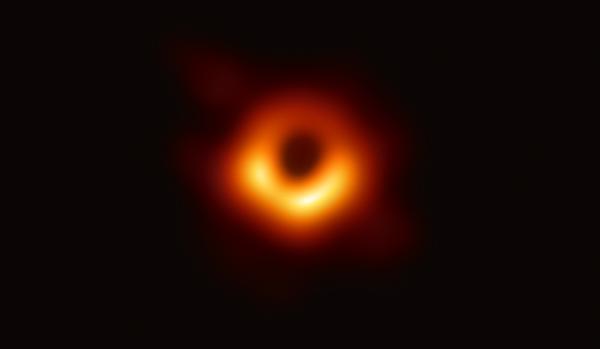
Image description: The black hole is invisible, it is a point at the center of this image taken in the millimeter domain (1.3 mm wavelength). The dark central part surrounding the black hole of the galaxy M87 is the black hole's shadow, i.e., the sphere of the event horizon. The orange and yellow part is ionized gas rotating around the black hole. The brighter yellow light of the ionized gas is due to the relativistic Doppler effect, which makes the light coming towards us brighter than the light moving away from us. It was in April 2019 that astrophysicists revealed this simple halo of yellow-orange light, blurry and asymmetrical, which evokes a black hole. Image credit: EHT Interferometer (Event Horizon Telescope).
A black hole is a fascinating and mysterious astrophysical object that defies our understanding. Its mass is extremely high and its volume very small; it is a hole in spacetime, perhaps a point! We speak of singularity. This is why we never see a black hole but only the phenomena that appear around it and allow us to define it.
In the region around the black hole, the escape velocity equals the speed of light (Vech = c).
From the escape velocity, we can calculate the radius of this zone, called the event horizon, V²ech = 2 GM/R.
The radius of the black hole, which corresponds to the event horizon, is proportional to its mass r = 2GM/c^2 (Schwarzschild radius) where G is the gravitational constant, M is the mass of the black hole, and c is the speed of light.
For example, for a black hole with a solar mass, we obtain a radius of 3 km; in other words, a sphere like the Sun, which has a radius of 696,340 km, would need to be condensed to 3 km to become a black hole.
The shadow of a black hole is a phenomenon predicted by Albert Einstein's theory of general relativity (1879-1955).
Due to its intense gravitation, a black hole prevents light from escaping the dark and spherical region that forms around it in spacetime. This region represents the black hole's shadow. The light is so bent by the black hole's gravity that it remains trapped in this zone, which appears black to us.
The shadow of the black hole measures one light-week (about 18.6 billion km) in this image. The shadow of the black hole is not the black hole itself but its manifestation.
The event horizon and the shadow of a black hole are two different concepts but intimately linked as they represent the same region of space.
- The event horizon is an imaginary spherical surface marking the boundary of the spacetime region where the gravitational field is strong enough to prevent any matter or radiation from escaping.
- The black hole's shadow is a dark region observed in an image, caused by the gravitational capture of photons. It does not represent a physical volume but a projected zone in the sky where no light ray from background matter or orbit reaches the observer. This shadow is formed by light rays passing near the "photon sphere," outside the event horizon, but are deflected to fall into the black hole.
In other words, the formation of a black hole's shadow is caused by the light-bending effect around the black hole.
Light coming from behind a black hole is bent following the contours of deformed spacetime. It is so bent that it cannot reach a distant observer, thus creating a dark region in the observer's field of view.
In summary: The shadow of a black hole is a dark region appearing in a sky image, corresponding to the angular direction from which no light ray can reach the observer. It does not correspond to a physical structure inside the event horizon but results from the gravitational capture of photons that approach the black hole too closely. This shadow extends well beyond the horizon, and its apparent size is determined by the critical null geodesics that spiral into the black hole from the "photon sphere."